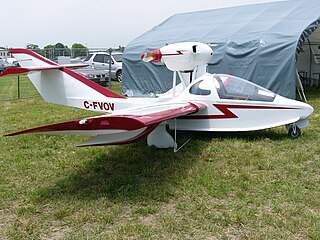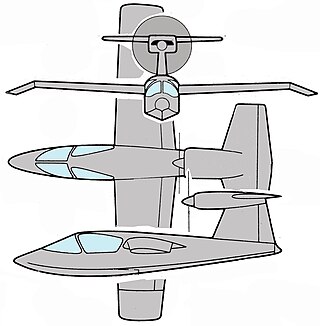
The Taylor Coot is a two-seat homebuilt amphibious aircraft designed by Moulton Taylor, famous for his flying car designs. When a market for the Aerocar did not emerge, Taylor turned to more conventional designs. The Coot was nonetheless somewhat unusual for its low wing, a feature uncommon on most seaplanes and flying boats, which conventionally strive to keep their wings as far away from the water as possible. Instead, Taylor designed the Coot's wing roots to act as sponsons to stabilise the craft in the water. The arrangement allowed him to do away with the weight and drag penalties imposed by wingtip floats, and additionally gain ground effect benefits during takeoff. First flown in 1969, the Coot proved very popular with homebuilders, with an estimated 70 aircraft completed by 2007.

The Air Tractor AT-400 is a family of agricultural aircraft that first flew in the United States on September 1979. Type certification was awarded to Air Tractor in April 1980. Of low-wing monoplane taildragger configuration, they carry a chemical hopper between the engine firewall and the cockpit.

The PZL-105 Flaming (flamingo) is a Polish short-takeoff-and-landing (STOL) utility aircraft designed by PZL "Warszawa-Okęcie". It remained a prototype.

The Goodyear GA-2 Duck was a 1940s American three-seat light amphibious aircraft built by the Goodyear Aircraft Corporation. The design team included David Thurston, who later developed several other light seaplanes including the Colonial Skimmer, Lake Buccaneer, Thurston Teal and Seafire. Only 19 aircraft were built, and these were used only for testing and as demonstrators.

The PZL-102 Kos (blackbird) is a Polish two-seat touring and training monoplane designed and built by PZL.
The Partenavia P.59 Jolly was an Italian two-seat training monoplane designed by Partenavia to meet a requirement for the Aero Club d'Italia. First fight was in 1960.
The Larkin Skylark is single-engine amphibious homebuilt aircraft. Only one aircraft was built and flown in 1973.

The Jurca MJ-5 Sirocco is a two-seat sport aircraft designed in France in the early 1960s and marketed for homebuilding. It is one of many wooden homebuilt designs from Romanian born designer Marcel Jurca. Jurca, a Henschel Hs 129 pilot in World War II marketed the plans in Canada and America through Falconar Aviation. It is a low-wing cantilever monoplane of conventional configuration and wooden construction throughout. The tandem seats are enclosed by a bubble canopy, and the tailwheel undercarriage can be built as either fixed or with retractable main units. Marcel Jurca died on 19 October 2001, at which time plans were still available from the designer's website.

The Malmö MFI-10 Vipan was a four-seat light utility monoplane designed and built in Sweden by Malmö Flygindustri. Only three aircraft were built and the type did not enter quantity production.

The Osprey Osprey 2, also known as the Pereira Osprey 2 after its designer, is an amphibious sport aircraft designed for homebuilding. Plans have been sold since the mid-1970s. George Pereira designed the Osprey 2 to address the two most frequent criticisms of his Osprey I aircraft: its lack of a passenger seat and its inability to operate from dry land. An exercise that began as a series of modifications to the original design in January 1972 eventually turned into a complete redesign of the aircraft, with the resulting Osprey 2 flying in April 1973.
The Hongdu N-5,, originally known as the Nanchang N-5, is a Chinese agricultural aircraft. First flown in 1989, and entering into production in 1992, the N-5 is a single-engined low-wing monoplane, and is available in versions powered by a piston engine or a turboprop.

The Robin R 3000 is a French single-engined light aircraft designed and built by Avions Robin, which entered production in the 1980s.
The Fisher Culex and Culite are a family of American two-seat, twin-engined monoplanes. The aircraft is supplied in the form of blueprints for amateur construction, originally by Fisher Flying Products and now by Mike Fisher Aircraft.
The Terzi T-9 Stiletto is an Italian two-seat light aircraft designed by Milanese aeronautical engineer Pietro Terzi who built a demonstrative prototype at his firm Terzi Aerodyne based in Milan, Italy.

The Krunichev T-411 Aist is a Russian light utility monoplane designed by the Russian company Aeroprogress and placed into production by the Khrunichev State Research and Production Space Center. A version is marketed in the United States as the Aeroprogress T-411 Wolverine powered by a Continental TSIO-550-B.

The Zenair Tri-Z CH 300 is a three-seat Canadian homebuilt light aircraft. A single-engined low-winged monoplane, the CH 300 first flew in 1977, with several hundred kits sold.
The Sequio 300 Sequoia is an American two-seat utility or aerobatic aircraft, designed by David Thurston for Sequoia Aircraft Corporation for sale as a kit or set of plans for homebuilding.
The Fournier RF-47 is a 1990s French two-seat light aircraft designed and built by Avions Fournier. First flown 9 April 1993, it is a low-wing tricycle landing gear monoplane. The prototype was powered by a 90 hp (67 kW) Sauer modified Volkswagen air-cooled engine but it was intended that production aircraft would be fitted with a 90 hp (67 kW) Limbach L2400 engine with the Sauer engine as an option. The RF-47 has an enclosed cockpit with side-by-side configuration seating for two under a single piece canopy, the canopy hinges at the rear.

The Volmer VJ-24W SunFun is an American high-wing, strut-braced, single-seat, pod-and-boom motor glider and ultralight aircraft that was designed by Volmer Jensen and provided as plans for amateur construction by his company Volmer Aircraft of Glendale, California.

The Island X-199 Spectra was a prototype technology demonstrator designed to test several concepts in amphibian aircraft design in anticipation of a future production variant. Originally known as the "Spectra", it later was renamed for marketing purposes, the "X-199".















